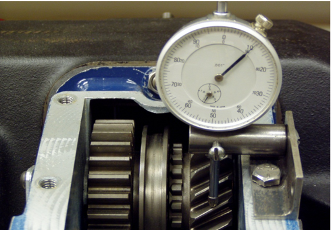Troubleshooting: PTO Noise
A common troubleshooting issue is noise coming from a power take-off (PTO); however, it is not always easy to diagnose. Hopefully, these tips will help you narrow down the root cause of PTO noise.
Before installation
When planning to mount a PTO to a transmission, it is recommended to first run the application without the PTO installed and listen for any noises. This will help to determine if the noise began after the PTO was installed or if the noise was already present.
Another step that can be taken before mounting the PTO is to inspect the transmission gear and the PTO gear for knicks or dings from handling issues prior to assembly, as these can cause noise.
One last step is to spin the PTO gear to listen for internal noise before it is mounted.
During installation
Setting the correct PTO backlash upon installation is an important step in reducing or eliminating noise. The correct backlash for most Muncie Power Products’ PTOs is .006" to .012".
Too small of tolerance of backlash will cause a whining noise and excess pressure on the idler shaft and bearings. Too much backlash will cause a chattering noise. The chattering noise may diminish when RPMs are increased or the PTO is put under a load.
If the noise caused by backlash cannot be totally alleviated by adding or removing gaskets, a chatter would be better than a whine, as a PTO mounted too tight can cause issues previously mentioned.
Here is an example of a gauge to check backlash:

The following instructions for using a dial indicator can be found in Muncie Power’s installation manual. For example, below is an excerpt for all 6- and 8-Bolt PTOs.
“Use of a dial indicator can greatly improve the quality of the installation. Mount the indicator so that the plunger aligns with a tooth on the PTO input gear. Hold the transmission gear with a screwdriver or bar and rock the PTO gear back and forth with your hand. The total movement on the dial indicator should be between .006"–.012".” Source: IN84-03, page 1.5
Note: Several PTOs, such as those on Ford automatic and Allison 3000–4000 Series transmissions, have predetermined backlashes set by the transmission manufacturer and require no backlash check by the installer.
After installation
Once a PTO is installed, there are a few things that can be done to determine the root cause. One question to ask: Does the noise get worse or better if RPMs are increased or if the PTO is put under a load? This might indicate a backlash noise.
Another question to ask: Is the noise there all the time or only when the PTO is engaged?
Other possible noise sources
The PTO, being a metal appendix attached to the transmission, will often highlight or exaggerate noises due to its design. Some other possible sources of noise can be pumps, drivelines, or even hoses. One way to determine whether noise is coming from the PTO or another component in the system is to disconnect the pump or driveline from the PTO (if possible) to see if the noise persists. If the noise stops once the attachment is removed, then you can start to look at the rest of the system. It could be a cavitating pump caused by the improper size of hose, the wrong type of inlet hose, a hose routing issue, or an unsecured hose, which can vibrate and “jump,” causing noise. A driveline can be out of phase or have other issues that can cause noise.
Another possible source of PTO noise could be the PTO is mounted too close to parts of the truck, such as the floorboard, frame rail, brackets, cross members, spring shackles, or other components. As the engine and transmission flex, the PTO moves with them and can be hitting these things, thus causing noise.
PTO noise on transmissions with live drive transmission gears can be quite common due to the torsional vibration of the engine. Allison and Ford are transmissions with common PTO noise complaints. On Ford transmissions, specifically, great strides have been taken to reduce the torsional vibration noise emitted out of the PTO, such as Muncie Power’s FR6Q and F20; however, some PTO noise on these may be inevitable.


